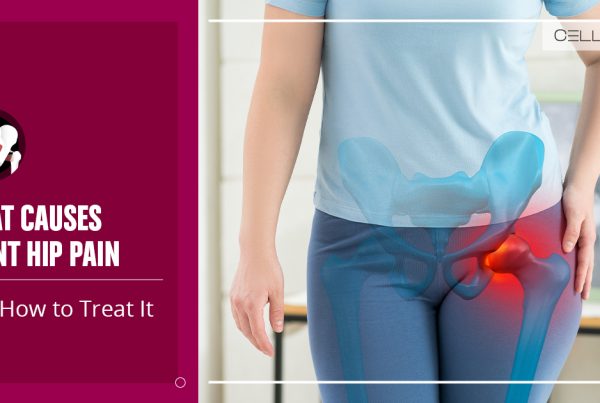Published on: September 12, 2022 | Updated on: August 29, 2024
Hip pain sometimes travels down to the knee or lower leg, causing difficulty performing daily activities. The pain usually occurs in the front, back, or side of the hip. The nerves running through the hip to the legs carry this pain to the thigh, knee, and lower limb.
This hip pain can also cause stiffness in your joints and muscles. As a result, you’ll struggle standing up, driving, sitting, walking, and even putting on shoes.
There are many causes of hip pain radiating down the leg to the knees, such as hip osteoarthritis, labral tear, sciatica, and iliopsoas bursitis. Visiting a professional healthcare provider in the early stages is recommended for on-time treatment.
The Anatomy of Hip Joint
The hip joint consists of a ball and socket joint. The thigh bone is the ball that fits into the hip socket. The hip socket is known as the acetabulum. It is covered with a soft tissue or fibrocartilage called the labrum.
The labrum maintains stability and enhances the surface area of the hip joint by 22%. However, it is susceptible to wear and tear and several injuries, like impingement, congenital malformation (dysplasia), and joint laxity.
Causes of Hip Pain that Radiates Down the Leg

Hip pain can occur due to several conditions of the hip joint. The most common ones include:
Hip Osteoarthritis
Hip osteoarthritis is the wear and tear of the hip joint, resulting in severe pain in the hip and the groin area. This pain can travel to the front region of your thighs and knees and sometimes to the lower knee area.
You may feel an aching pain in the morning or after sitting or resting for a long time. It can also occur after performing a physically demanding activity. In severe cases, your hip joint may make a loud locking or grinding sound during the movement.
Hip Labral Tear
Any injury or tear in the labrum can cause severe hip pain radiating down the leg to the knee. Hip labral tears commonly cause pain in the groin region and side area of the hip. You’re likely to feel labral tear pain during or after a workout.
If not treated early, you may feel labral tear pain during less demanding activities like sitting and walking.
Hip Impingement
Hip osteoarthritis and labral tears can occur due to abnormal contact between the hip joint bones. Both of these conditions may result in hip impingement. It causes pain in the front and side regions of your hip that travels to the front area of your knee and thigh.
This pain can worsen when sitting, squatting, or doing activities that make the hip move.
Iliopsoas Bursitis
The iliopsoas bursa is a small, thin sac filled with fluid in the front part of the hip. Inflammation in this part can cause hip pain that spreads down the leg to the knee. You may feel this pain in the groin region, particularly when bending the knee close to the chest.
Iliopsoas bursitis inflammation can also lead to snapping hip syndrome. This condition refers to when the joint makes a snapping or clicking sound during the movement. The snaps are usually felt when you straighten your hips from a flexed position, like standing up.
Sciatica
Hip pain radiating down the leg to the knee can also occur when the lumbar and sacral nerve roots irritate. This condition is called sciatica. Other musculoskeletal conditions can cause sciatica pain, such as piriformis syndrome and sacroiliac joint dysfunction.
Treatment Options for Hip Pain Radiating Down the Leg to Knee
Severe hip pain that does not go away with preventive methods requires immediate medical attention. Your healthcare provider may suggest conservative care or orthobiologic methods for your condition.
Conservative Care
Conservative care for hip pain comprises:
- Anti-inflammatory Medications. The doctor may recommend over-the-counter anti-inflammatory medications such as naproxen and ibuprofen for pain management. You can better tolerate the pain with these drugs. If the pain aggravates, the doctor may prescribe you more potent medicines.
- Physical Therapy. It is the best non-invasive method to treat mild hip pains. Your physiotherapist will help you practice exercises that strengthen your hip joint and relieve pain.
- Corticosteroid Injections. Your doctor may opt for an anti-inflammatory or corticosteroid injection as an instant pain reliever. It is mainly used for patients with arthritis as a short-term treatment. Long-term use of corticosteroid injections may damage the soft tissues of your hip joint.
- Surgery. When nothing works, your doctor will undergo an arthroscopy surgical procedure on the hip joint. In this surgery, the surgeon inserts a narrow gauge camera and multiple operating tools into the hip joint. This gives them a clear view of the inside structures, especially the labrum.
Orthobiologic Treatment
If you’re experiencing unbearable hip pain radiating down the leg to the knee, you can go for a less painful method: orthobiologic treatment. This option involves cell-based therapy and plasma-rich platelet (PRP) therapy.
These orthobiologic treatments replace inflamed or damaged tissues and cells with newer, healthy ones.
Also known as stem-cell therapy, cell-based therapy primarily consists of two types of transplant: Minimally Manipulated Adipose Tissue Transplant (MMAT) and Bone Marrow Concentrate (BMAC). MMAT focuses on your fatty tissues and replaces the damaged ones with healthy tissues. On the other hand, BMAC involves transplanting the affected bone marrow cells with new ones.
If you need an MMAT in several body parts, the doctor will cater to all the affected areas in the same procedure.
Cell-based therapy is usually completed within 1.5-2 hours, and you may go home right after as per the doctors’ suggestion.
Platelet-Rich Plasma (PRP) therapy is a well-known treatment for spine and orthopedic conditions. It focuses on enhancing the growth of healthy tissues in your body.
Platelets are present in the blood to promote healing in your body. They produce a sticky web-like structure called fibrin that promotes tissue development in the affected area. An increased number of regenerative cells boosts recovery and prevents injuries. PRP usually takes 45 minutes to complete.
Sources
Footnotes
- Wilson JJ, Furukawa M. Evaluation of the patient with hip pain. American family physician. 2014;89(1):27-34.
- Seldes RM, Tan V, Hunt J, Katz M, Winiarsky R, Fitzgerald Jr RH. Anatomy, histologic features, and vascularity of the adult acetabular labrum. Clinical Orthopaedics and Related Research (1976-2007). 2001;382:232-40.
- Lam S, Amies V. Hip arthritis presenting as knee pain. BMJ Case Reports. 2015;2015:bcr2014208625.
- Di Carlo M, Draghessi A, Carotti M, Salaffi F. An Unusual Association: Iliopsoas Bursitis Related to Calcium Pyrophosphate Crystal Arthritis. Case Rep Rheumatol. 2015;2015:935835.
- Margo K, Drezner J, Motzkin D. Evaluation and management of hip pain: an algorithmic approach. Journal of family practice. 2003;52(8):607-19.
References
- Hip Pain That Travels Down the Leg. Arthritis-Health. Accessed 9/7/2023.
- Hip Pain. Versus Arthritis. Accessed 9/7/2023.
- Hip and Leg Pain. Intermountain Health. Accessed 9/7/2023.
CELLAXYS does not offer Stem Cell Therapy as a cure for any medical condition. No statements or treatments presented by Cellaxys have been evaluated or approved by the Food and Drug Administration (FDA). This site contains no medical advice. All statements and opinions are provided for educational and informational purposes only.
Dr Pouya Mohajer
Author
Pouya Mohajer, M.D. is the Director of Spine and Interventional Medicine for CELLAXYS: Age, Regenerative, and Interventional Medicine Centers. He has over 20 years of experience in pain management, perioperative medicine, and anesthesiology. Dr. Mohajer founded and is the Medical Director of Southern Nevada Pain Specialists and PRIMMED Clinics. He has dedicated his career to surgical innovation and scientific advancement. More about the doctor on this page.
Dr Pejman Bady
Contributor
Dr. Pejman Bady began his career over 20 years ago in Family/Emergency Medicine, working in fast-paced emergency departments in Nevada and Kansas. He has served the people of Las Vegas as a physician for over two decades. Throughout this time, he has been met with much acclaim and is now the head of Emergency Medical Services in Nye County, Nevada. More about the doctor on this page.









